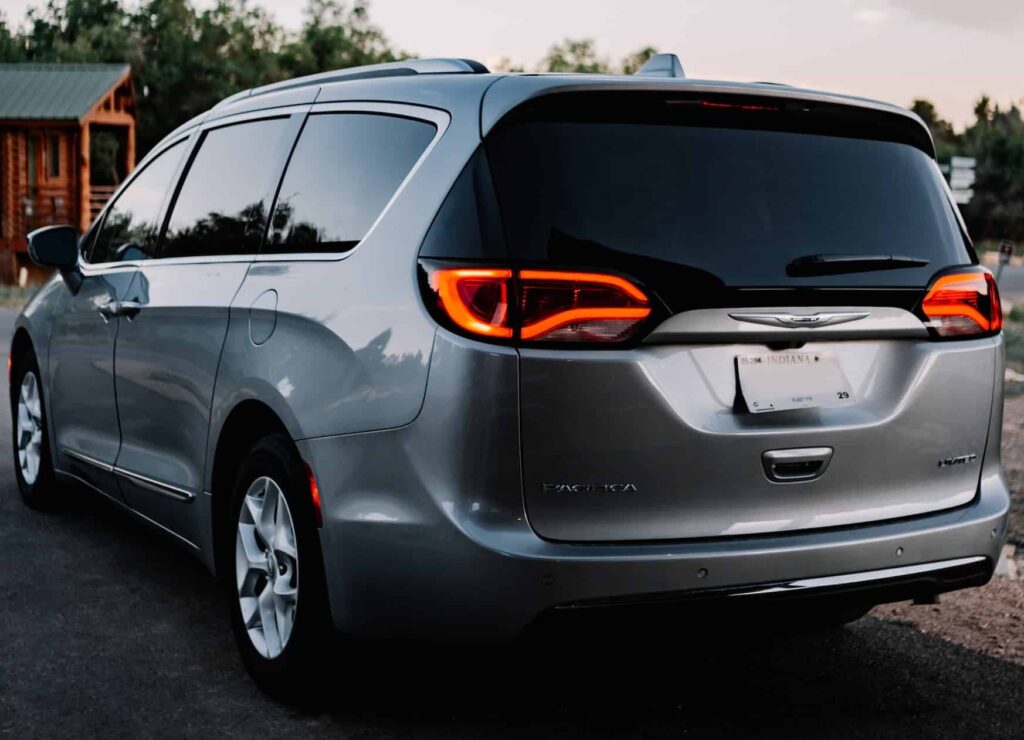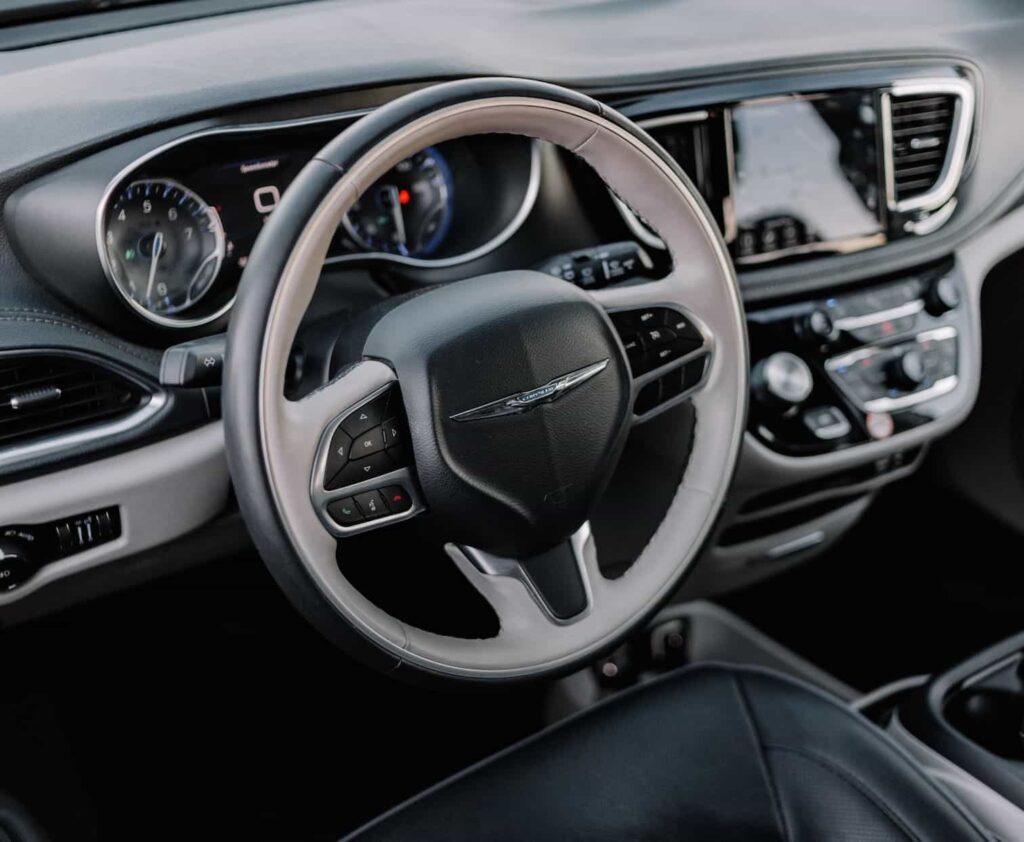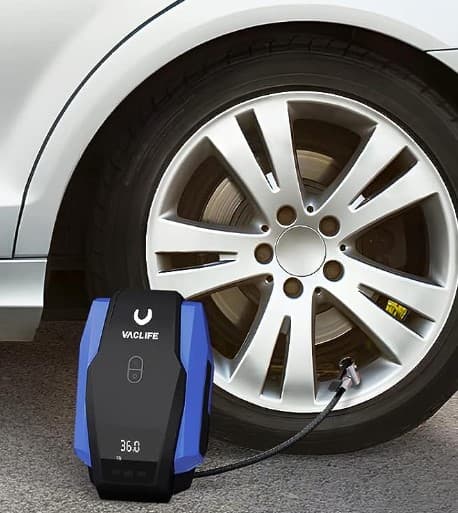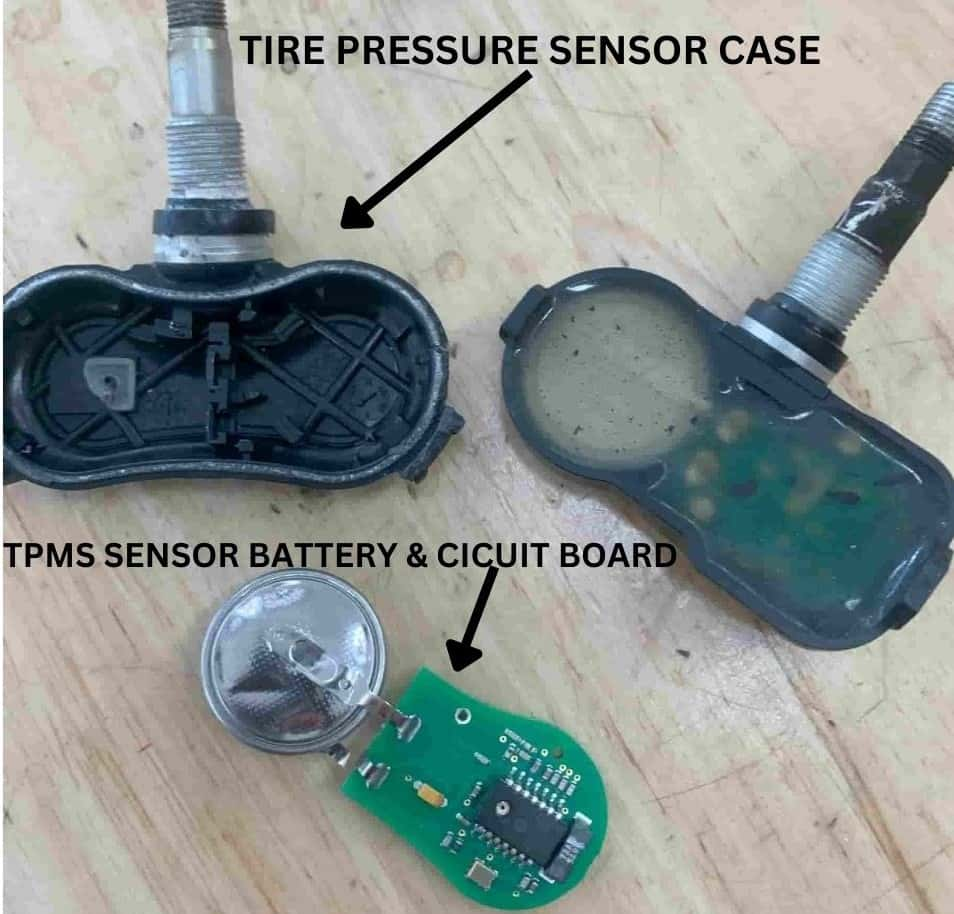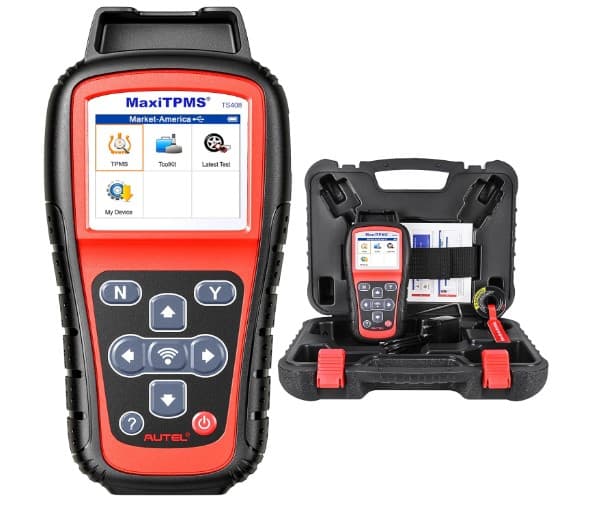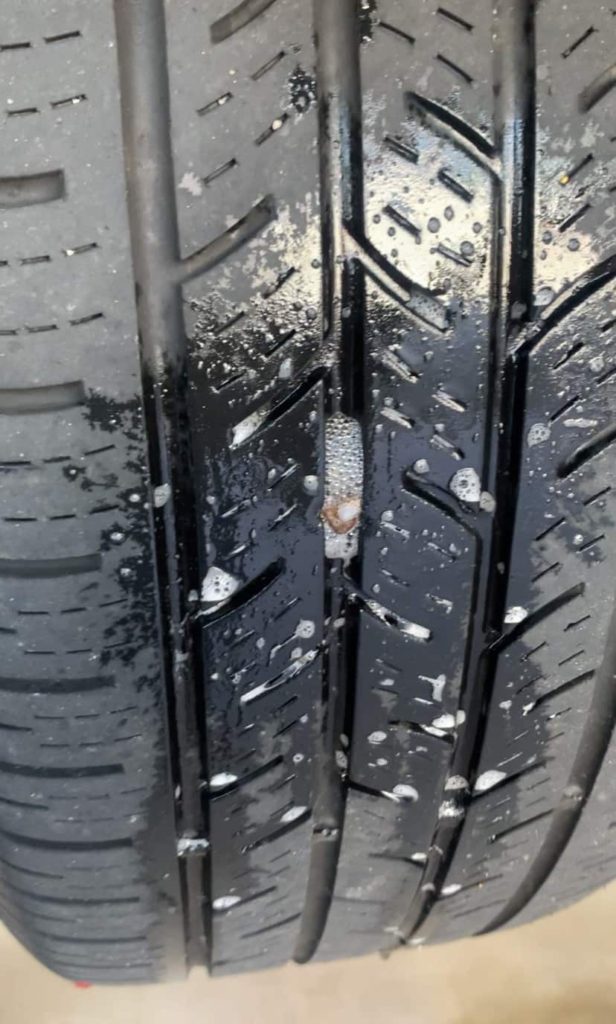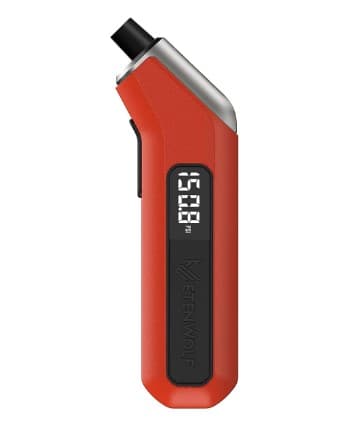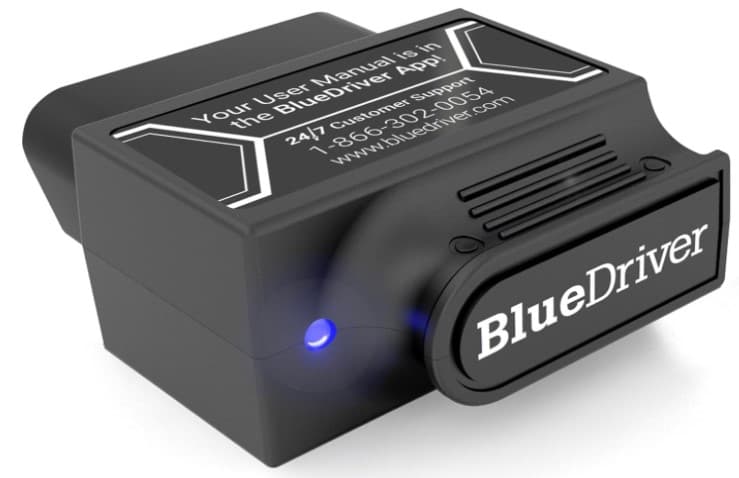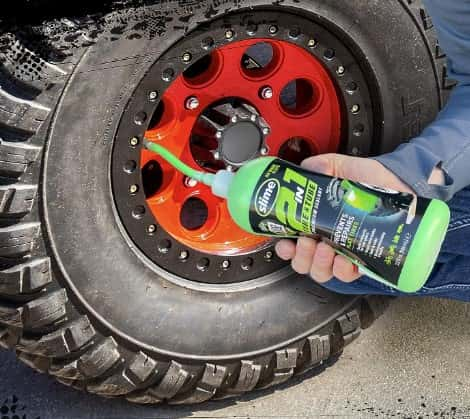What is the Chrysler Pacifica TPMS?
The Chrysler Pacifica TPMS (tire pressure monitoring system) comprises tire pressure sensors, a TPMS receiving module, the main ECM computer of the Pacifica, and alerts for low tire pressure. These components collaboratively monitor and report the tire’s current pressure, notifying the driver if the pressure goes under a specified limit.
How Does the Chrysler Pacifica TPMS Work?
Tire Pressure Sensors: Each tire of the Chrysler Pacifica is embedded with a specialized sensor. Concealed unless the tire is off the wheel, these sensors, anchored to the valve stem’s base, record air pressure and temperature continually. They’re fashioned from a circuit board with an antenna, kept powered by a battery, all enclosed in plastic.
Wireless Data Communication: These sensors beam tire data in real-time to the car’s digital system via radio waves, specifically using the 315 Mhz or 433 Mhz bands.
Receiver Module for TPMS: Acting as a bridge, this module fetches the data broadcasted by the sensors and readies it for analysis by the main computer of the Pacifica.
Chrysler Pacifica ECM: Here, the magic happens. The Engine Control Module evaluates the incoming data to ensure tire pressures and temperatures are optimal.
Low Pressure Alert: Should the ECM find a discrepancy in tire pressure, it immediately alerts the driver. A warning light illuminates on the dashboard, accompanied by a chime sound. The driver is further guided about which tire is under-inflated and the needed pressure: “Tire Low Inflate to XX PSI”.
TPMS Health Check: Beyond tire pressure, the system watches over its health. Any hiccup in sensor-ECM communication triggers a “SERVICE TPM SYSTEM” message as well as a blinking tire pressure light (yellow exclamation point).
How to REset the Chrysler Pacifica Tire Pressure Light
Park the Chrysler Pacifica on flat/level ground.
Ensure each of the 4 tires has the proper cold air pressure as recommended. If you can, wait for the tires to be cold before adjusting pressure.
Drive your Chrysler Pacifica for a minimum of 20 minutes over 15 mph or 24 km/h.
How to Deactivate the Chrysler Pacifica TPMS
If you aim to disable the Tire Pressure Monitoring System (TPMS) in your Chrysler Pacifica, you must substitute all four wheels with ones lacking tire pressure sensors. Upon deactivation, the tire light extinguishes, yet you will see (~) dashes instead of numeric tire pressure readings on your informational display. Here’s the procedure:
Exchange all four wheels and tires for those without TPMS sensors.
Drive your Chrysler Pacifica for a minimum of 20 minutes at speeds surpassing 15 mph.
Expect an audible chime from the tire pressure system.
The TPMS alert light (depicted as a yellow exclamation point) will flicker for approximately 75 seconds before remaining illuminated.
An alert saying “SERVICE TPM SYSTEM” will display, with dashes (~) replacing tire pressure readouts.
Power down the engine.
Re-ignite the engine.
Post ignition cycling, the “SERVICE TPM SYSTEM” message will disappear, yet dashes (~) will be presented in lieu of tire pressure figures.
How to Reactivate the Chrysler Pacifica TPMS
Reinstall the original equipment manufacturer (OEM) wheels and tires, ensuring they have the OEM tire pressure sensors (and are working), onto the Chrysler Pacifica.
Drive the Pacifica for a maximum of 20 minutes at speeds exceeding 15 mph (24 km/h).
Listen for a chime inside the cabin, which will be emitted by the tire pressure system.
Notice the TPMS indicator light (yellow exclamation mark) which will flash intermittently for roughly 75 seconds and then subsequently extinguish.
The message “SERVICE TPM SYSTEM” will appear on the information display screen.
Tire pressure readings will once again be visible, replacing the (~) dashes on the display.
Cycle the ignition between the on and off positions.
Proceed to drive the Chrysler Pacifica to complete the process.
2022 Chrysler Pacifica Tire Pressures
TIRE SIZE | FRONT PSI | REAR PSI |
235/65R17 | 36 | 36 |
235/60R18 | 36 | 36 |
245/50R20 | 36 | 36 |
What Can Cause the Chrysler Pacifica Low Tire Pressure Light to Turn On?
Tires not inflated enough
Overfilled tires
Tires losing air
Absent tire pressure monitoring sensors
Depleted battery in TPMS sensor
Complications with Pacifica TPMS receiver module or Engine Control Module
Disturbances from nearby electronics
Atmospheric or altitude shifts
Overburdening the vehicle
Application of chains or studs on tires
Intense window tinting
Fluctuations in the temperature of the road
Mismatched tire dimensions
Wheels not aligned properly
TPMS software glitches
Accidental bumps or collisions with curbs or potholes
Incorrect mounting of tires
Neglecting TPMS recalibration/reset post tire adjustments
Chrysler Pacifica Tire Pressure Sensor Batteries
The Chrysler Pacifica has a tire pressure sensor embedded inside every tire mounted on the wheel. They each consist of a miniaturized circuit board, an antenna, and a small silver-oxide battery, which is not replaceable or rechargeable due to its direct attachment to its circuit board. When the battery is low or exhausts its power, the whole sensor must be replaced. The Chrysler Pacifica tire sensor batteries are designed to last on average between 5 to 10 years or up to 100,000-150,000 miles of driving.
Troubleshooting TPMS Problems in the Chrysler Pacifica
The conventional method to reset the tire pressure for the Chrysler Pacifica might not always extinguish the tire light. If the light is illuminated, there’s a cause behind it. Discovering the root cause often involves a process of elimination, testing various fixes until success is achieved. Try the following solutions:
Solution 1: Is One of Your Tires Losing Air?
Should the tire light of your Chrysler Pacifica illuminate while on the road, it’s advisable to stop and manually inspect the air pressure in each tire. Once you’ve identified the tire that’s low on air, proceed as follows:
Fill the affected tire to the suggested 36 Psi, and ensure the other three are adjusted accordingly.
Drive your Chrysler for several minutes, making sure to go above 15 mph.
The tire light should then deactivate.
⏩ RESPONSE: Typically, if a single tire displays a lower air pressure than the rest, it points to a potential leak. If the tire pressure warning deactivates post-inflation and after driving the Pacifica, it’s clear that the decreased pressure was the issue. However, if the warning light reappears after initially turning off, reassess the tire pressures. Should the same tire demonstrate reduced air pressure, it indicates a leak. Refer to Solution 6 for guidance on detecting tire leaks.
Solution 2: How to Reset the Computer in a Chrysler Pacifica
The Chrysler Pacifica’s ECM retains every instance of a low tire pressure warning in its internal memory. If you’re keen on trying to remove these records, you can essentially initiate a reset of the ECM. Here’s how:
Ensure that the engine and all the electronic systems of the Chrysler are switched off, including the radio, lights, and so forth.
Pop the car’s hood open, and carefully detach the negative terminal from the 12-volt battery.
Pause for several minutes before reattaching and securely fastening the terminal back to the battery’s negative end.
It’s advised to drive the Chrysler Pacifica for roughly 30 minutes at freeway speeds post battery disconnection.
⏩ OBSERVATIONS: Once the ECM of the Pacifica is powered up again, the tire warning light should deactivate. If the low tire pressure alert re-emerges during or post-drive, it indicates a potential air leak in a tire or a weak or depleted battery in a tire pressure sensor. Proceed to the next solution for steps on testing and evaluating the performance of each tire pressure sensor.
Solution 3: Identifying a Malfunctioning Tire Pressure Sensor
If none of your tires seem to be deflating, yet the low tire pressure indicator remains lit, it suggests a possible malfunction or defect in the tire pressure sensor in one or multiple tires. For assessing each sensor, equip yourself with either a TPMS programming tool or an OBD2 diagnostic tool. While the diagnostic tool will merely identify the problematic wheel triggering the diagnostic trouble code, the TPMS programmer will pinpoint both the wheel and the reason behind the DTC. Here’s the procedure to evaluate each sensor using the TPMS programming device:
Link the TPMS programmer to your car’s OBD2 outlet, abiding by the on-screen guidelines.
Commence with the front-left tire (on the driver’s side) and position the device as near to the tire pressure valve or sensor as possible, then opt for the “test” or “trigger” feature on the device.
The TPMS programming tool will then test that sensor and then instruct you to move onto the next tire.
⏩RECAP: Once you’ve scrutinized all four TPMS sensors, the TPMS programming device will present a report. If, during the analysis, the tool fails to evaluate a sensor, produces erratic values (like a tire temperature reading of -105 degrees), or indicates a low battery, that particular TPMS sensor mandates a replacement.
Solution 4: How to Revive an Inactive Tire Sensor
On occasions, the tire light might illuminate due to an inactive tire pressure sensor. If the sensor’s battery isn’t the root cause, consider the following steps:
Release 15-20 Psi from the tire in question.
Pump up the tire to its suggested pressure, adding an extra 5 Psi. (For example, if it’s meant to be at 36 Psi, inflate it to 41 Psi)
Drive the Chrysler Pacifica, ensuring you surpass speeds of 15 Mph.
After driving, set the tire’s pressure back to the recommended level.
⏩RESULT: We advise resorting to this method if the usual tire pressure reset approach doesn’t yield results.
Solution 5: How Temperature Variations Affect Low Tire Pressure Alerts in the Chrysler Pacifica
Should you observe the low tire pressure light of your Chrysler Pacifica intermittently illuminating and turning off on its own, climatic variations are typically the culprits. Fluctuations in ambient temperature are a prevalent reason for the tire indicator’s activation. Generally, for every 12-degree shift in air temperature, tire pressure adjusts by approximately 1 Psi correspondingly. For instance, if the temperature drops from 70 to 30 degrees, there’s a reduction of around 4-5 Psi in tire pressure, prompting the light to turn on. As driving continues and temperatures rise, the tires warm, leading to increased internal air pressure and subsequent deactivation of the warning light.
⏩GUIDANCE: While weather conditions are beyond our control, one actionable measure is to calibrate and modify tire pressures when they’re cold. A tire is deemed cold if the Pacifica has been stationary for a minimum of 3 hours. This method facilitates the most precise setting of tire pressures, minimizing the impact of weather-induced variations.
Solution 6: How to Detect a Tire Leak Effectively
To accurately identify the source of a tire leak, gather the following items: a tire pump, a sprayer bottle, water, and soap/ detergent. Steps to detect the air leakage:
Combine water with soap (kitchen soap is ideal) and pour into the sprayer bottle.
Inflate the compromised tire to a minimum of 36 Psi.
Drench the tire using the soapy solution.
Examine the tire meticulously, searching for tiny air bubbles.
⏩UPCOMING STEPS: Once the air bubbles are spotted, trace them to their origin. This origin marks the spot of the puncture.
Chrysler Pacifica Tire Pressure Questions
How to Maintain TPMS Performance Following a Tire or Wheel Swap
Ensure to adhere to the TPMS reset procedure when changing or replacing the tires on your Chrysler Pacifica. Conversely, if you’re replacing the wheels or rims, it’s imperative to transfer the original tire pressure sensors to the new set or install new TPMS sensors. Subsequent to installation, programming the new sensors to communicate with the Pacificas ECM is necessary.
How to Handle Tire Pressure Changes at Varying Altitudes in a Chrysler Pacifica
Alterations in altitude present a unique challenge to maintaining stable tire pressure in a Chrysler Pacifica. As a general rule of physics, when climbing up, atmospheric pressure decreases which will cause tire pressure to decrease by 0.5 Psi for every 1,000 feet in elevation. For example, driving from a location at sea level up a mountain situated at 7,500 feet could potentially mean a 4.0 psi drop in tire pressure.
Can You Safely Drive a Chrysler Pacifica When the TPMS Light is On?
Should the tire light become illuminated on your Chrysler 300, ensure you find a safe spot to pull over and determine the root of the problem. Begin by conducting a visual check of each tire, then assess the tire pressure: is it too low? Conversely, is the pressure acceptable, yet the light continues to stay on? A light that stays on despite adequate pressure typically signifies a disconnect between one or more TPMS sensors and the Chrysler 300’s ECM. For the safety and security of all passengers and the vehicle itself, it’s pivotal to consult the aforementioned solutions to pinpoint and resolve the issue.
How Long Can You Drive the Chrysler Pacifica With the Low Tire Pressure Light On?
Operating a vehicle while the low tire pressure light is illuminated poses a considerable risk to the vehicle and its occupants. The permissible driving distance or duration with the low tire pressure light on is not fixed, as it is contingent upon various factors. If the tire pressure is suboptimal, inflation is essential before proceeding. Conversely, if the tire light remains active with adequate pressure, it indicates a TPMS failure. While a TPMS malfunction does not pose an immediate safety threat, continuing to drive without accurate tire pressure knowledge carries its own set of risks.
What Causes the Chrysler Pacifica Tire Light to Flash?
A blinking tire light indicates a communication breakdown between the tire pressure sensor and the TPMS receiver module or ECM in the Chrysler Pacifica, a scenario identified as a TPMS malfunction. Notably, this is not related to air pressure concerns. For instance, as the spare tire lacks a tire pressure sensor, its use means the ECM and TPMS receiver module lack a communication partner, triggering a TPMS malfunction. Similar issues can arise if a tire pressure sensor is low on battery or has been depleted.
Repairing Tire Punctures With Tire Plugs
Tire plugs have proven to be notably dependable for repairing punctures located on a tire’s tread in my experience. However, they should not be utilized if the tire tread is significantly worn or if the puncture is on the tire’s sidewall.
The Effects of Using Tire Sealants on Tire Pressure Sensors
While tire sealants like Fix-a-Flat or Slime can be handy in urgent scenarios, they may inadvertently inflict damage on the tire pressure sensors and also create tire imbalances.
Everything in this article is applicable to all Chrysler Pacifica models and versions including the Chrysler Pacifica Plug-in-Hybrid, Pacifica Touring, Touring L, Limited, and Pinnacle.
Please note that this blog post contains Amazon affiliate links. This means that if you make a purchase through one of these links, we at TPMSRESET.COM may earn a small commission at no extra cost to you. We only recommend products that we personally use and believe in. Thank you for supporting us.
